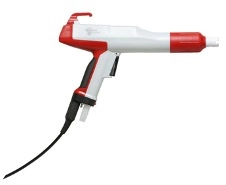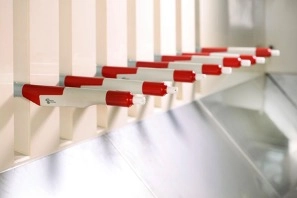Content Menu
● Understanding Spray Gun Technology
>> What is HVLP?
>> What is a Conventional Spray Gun?
● Key Differences Between HVLP and Conventional Spray Guns
>> 1. Pressure and Airflow
>> 2. Transfer Efficiency
>> 3. Application Speed
>> 4. Finish Quality
>> 5. Material Compatibility
● Advantages and Disadvantages
>> Advantages of HVLP Spray Guns
>> Disadvantages of HVLP Spray Guns
>> Advantages of Conventional Spray Guns
>> Disadvantages of Conventional Spray Guns
● Choosing the Right Spray Gun for Your Project
>> Consider Your Project Needs
>> Testing and Experimentation
● Maintenance and Care
● Conclusion
>> Frequently Asked Questions
When it comes to painting and finishing projects, the choice of spray gun can significantly impact the quality of the finish, the efficiency of the application, and the overall experience of the user. Two of the most common types of spray guns are High Volume Low Pressure (HVLP) and conventional spray guns. Understanding the differences between these two types can help you make an informed decision for your next project.

Understanding Spray Gun Technology
What is HVLP?
HVLP stands for High Volume Low Pressure. This technology was developed to reduce overspray and improve transfer efficiency. HVLP spray guns operate by using a high volume of air at a low pressure, typically between 7 to 14 psi. This allows for a finer mist of paint, which results in a smoother finish and less waste of material.
What is a Conventional Spray Gun?
Conventional spray guns, on the other hand, operate at higher pressures, usually between 30 to 50 psi. They atomize the paint using a high-pressure air stream, which can lead to more overspray and waste. However, conventional guns can apply thicker coatings more quickly, making them suitable for certain applications where speed is essential.
Key Differences Between HVLP and Conventional Spray Guns
1. Pressure and Airflow
- HVLP Guns: Use a high volume of air at low pressure. This results in a softer spray that minimizes overspray and improves transfer efficiency.
- Conventional Guns: Utilize high pressure to atomize the paint, which can lead to more overspray and less efficient use of materials.
2. Transfer Efficiency
- HVLP Guns: Typically have a transfer efficiency of around 65% to 90%. This means that a higher percentage of the paint reaches the surface being painted, reducing waste.
- Conventional Guns: Generally have a lower transfer efficiency, often around 30% to 50%, leading to more paint being lost to overspray.
3. Application Speed
- HVLP Guns: While they provide a finer finish, they may require more time to cover large areas due to their lower material output.
- Conventional Guns: Can apply paint more quickly, making them ideal for large projects or when time is a critical factor.
4. Finish Quality
- HVLP Guns: Produce a smoother finish with less texture, making them ideal for fine finishing work, such as furniture or automotive painting.
- Conventional Guns: Can create a thicker coat, which may be desirable for certain applications but can also lead to a less refined finish.
5. Material Compatibility
- HVLP Guns: Best suited for low to medium viscosity materials, such as lacquers, stains, and some paints.
- Conventional Guns: Can handle a wider range of materials, including thicker paints and coatings, due to their higher pressure capabilities.
Advantages and Disadvantages
Advantages of HVLP Spray Guns
- Reduced Overspray: The low pressure minimizes overspray, making HVLP guns more environmentally friendly and cost-effective.
- Better Transfer Efficiency: More paint reaches the surface, reducing waste and saving money on materials.
- Smoother Finish: Ideal for detailed work and fine finishes.
Disadvantages of HVLP Spray Guns
- Slower Application: May take longer to cover large areas due to lower material output.
- Limited Material Use: Not suitable for very thick materials.
Advantages of Conventional Spray Guns
- Faster Application: Higher pressure allows for quicker coverage of large areas.
- Versatile Material Use: Can handle a wider variety of paint viscosities.
Disadvantages of Conventional Spray Guns
- Higher Overspray: More paint is wasted due to overspray, which can be costly and environmentally unfriendly.
- Less Efficient: Lower transfer efficiency means more material is lost during application.
Choosing the Right Spray Gun for Your Project
Consider Your Project Needs
When deciding between HVLP and conventional spray guns, consider the following factors:
- Type of Project: For fine finishing work, such as furniture or automotive painting, an HVLP gun is often the best choice. For larger projects where speed is essential, a conventional gun may be more appropriate.
- Material Type: If you are working with thicker paints or coatings, a conventional spray gun may be necessary. For thinner materials, HVLP guns are usually sufficient.
- Budget: HVLP guns can be more expensive upfront, but their efficiency can save money on materials in the long run.
Testing and Experimentation
If possible, test both types of spray guns on a small area before committing to a larger project. This will give you a better understanding of how each gun performs with your specific materials and application techniques.
Maintenance and Care
Regardless of the type of spray gun you choose, proper maintenance is crucial for optimal performance. Here are some tips:
- Clean After Use: Always clean your spray gun immediately after use to prevent paint from drying inside the nozzle and other components.
- Check for Wear: Regularly inspect your spray gun for any signs of wear or damage, especially the nozzle and air cap.
- Follow Manufacturer Instructions: Adhere to the manufacturer's guidelines for maintenance and operation to ensure longevity and performance.
Conclusion
In summary, both HVLP and conventional spray guns have their unique advantages and disadvantages. The choice between the two ultimately depends on your specific project requirements, the materials you are using, and your personal preferences. By understanding the differences and considering your needs, you can select the right spray gun to achieve the best results for your painting projects.

Frequently Asked Questions
1. What is the main advantage of using an HVLP spray gun?
- The main advantage is reduced overspray and higher transfer efficiency, which saves paint and provides a smoother finish.
2. Can I use thick paints with an HVLP spray gun?
- HVLP guns are best suited for low to medium viscosity materials. For thick paints, a conventional spray gun is recommended.
3. How do I maintain my spray gun?
- Clean your spray gun immediately after use, check for wear, and follow the manufacturer's maintenance guidelines.
4. Which spray gun is better for automotive painting?
- HVLP spray guns are generally preferred for automotive painting due to their ability to produce a fine finish with less overspray.
5. Is it worth investing in an HVLP spray gun?
- Yes, if you frequently work on projects that require a smooth finish and want to minimize waste, an HVLP spray gun can be a worthwhile investment.
Hot Tags: China, Global, OEM, private label, manufacturers, factory, suppliers, manufacturing company










































 .
. 